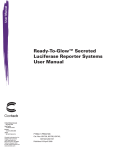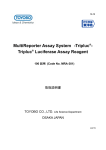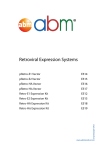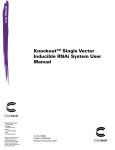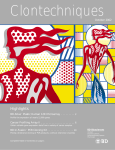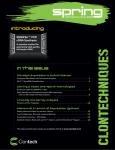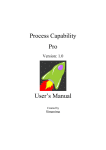Download Pathway Profiling System User Manual
Transcript
User Manual Pathway Profiling System User Manual United States/Canada 800.662.2566 Asia Pacific +1.650.919.7300 Europe +33.(0)1.3904.6880 Japan +81.(0)77.543.6116 Clontech Laboratories, Inc. A Takara Bio Company 1290 Terra Bella Ave. Mountain View, CA 94043 Technical Support (US) E-mail: [email protected] www.clontech.com Cat. Nos. Many PT3286-1 032712 Pathway Profiling System User Manual Table of Contents I. Introduction 4 II. Pathway Profiling Vectors 6 III. Products for Signal Transduction Research 7 IV. List of Components 8 V. Additional Materials Required 9 VI. General Considerations 10 A. Use of Controls 10 B. Transfection Considerations 10 C. Optimization of Transfection 11 VII. Pathway Profiling System Procedure 12 VIII. Troubleshooting Guide 14 IX. References 15 X. Related Products 15 Appendix: Pathway Profiling System Vectors 16 Clontech Laboratories, Inc. www.clontech.com 2 Protocol No. PT3286-1 Version No. 032712 Pathway Profiling System User Manual List of Figures Figure 1. General scheme for the Pathway Profiling procedure 5 Figure 2. An overview of the cis-acting enhancer element vector constructs in the Pathway Profiling Systems 6 Figure 3. Generalized map of the Pathway Profiling Vectors 18 Figure 4. Map and multiple cloning sites of pTAL-SEAP/Luc Vector 19 Figure 5. Map and multiple cloning sites of pTA-SEAP/Luc Vector 20 Figure 6. Map and multiple cloning sites of pSEAP2-Control Vector 21 List of Tables Table I. Signaling Pathways Represented in the Pathway Profiling Systems 5 Table II. Culture Plate Conversion 11 Table III. Pathway Profiling Vector Information 16 Protocol No. PT3286-1 www.clontech.com Version No. 032712 Clontech Laboratories, Inc. 3 Pathway Profiling System User Manual I. Introduction The Pathway Profiling Systems allow you to quickly profile the effects of a given stimulus, drug candidate, or gene of interest on key signal transduction pathways in vivo. The Pathway Profiling Systems cover a variety of signal transduction pathways in eukaryotic cells. Pathway Profiling Systems are available for broad-spectrum or targeted profiling of key signaling pathways: • SEAP System—broad coverage • Luciferase System 4—cell cycle Each kit is composed of several different reporter vectors that contain a specific cis-acting DNA sequence (enhancer element) and a sensitive reporter gene. Thus, you can monitor the binding of transcription factors to enhancer elements and screen for the induction of key signaling pathways. Table I shows the signaling pathways represented in the Pathway Profiling Systems. For a list of vector sets provided in each system, see List of Components (Section IV). Pathway profiling allows you to obtain preliminary evidence regarding the role of your gene or drug candidate in the activation of key signaling pathways. Along with a Profiling System vector set, each system includes all the reagents for performing standard calcium phosphate transfections. Figure 1 illustrates the general scheme for performing the pathway profiling procedure. Assay materials to detect SEAP or luciferase are not included; see Additional Materials Required (Section V) for ordering information. table i. signaling pathways represented in the pathway profiling systems cis-acting Enhancer Element Abbrv. Activator protein 1 AP1 cAMP response element CRE E-box DNA binding element E-box E2F DNA binding element E2F Estrogen response element ERE Glucocorticoid response element GRE Heat shock response element HSE IFN-γ activation sequence GAS Interferon-stimulated ISRE response element Nuclear factor of activated T-cells NFAT Nuclear factor of κB cells NFκB p53 response element p53 Retinoic acid response element RARE Rb response element Rb STAT3 response element STAT3 Serum response element SRE Thyroid response element TRE Transcription factor(s) c-jun/c-fos ATF2/CREB Myc/Max E2F/DP1 estrogen receptor GR HSF STAT1/STAT1 STAT1/STAT2 Signal transduction pathway(s) JNK JNK/p38 & PKA cell proliferation cell cycle progression estrogen receptor glucocorticoid/HSP90 heat shock response proliferation/inflammation proliferation/inflammation NFAT NFκB p53 RAR Rb STAT3/STAT3 Elk-1/SRF Thyroid receptor PKC & Ca2+/calcineurin NFκB cell growth/apoptosis retinoic acid receptor cell cycle progression proliferation/inflammation MAPK/JNK thyroid hormone receptor Clontech Laboratories, Inc. www.clontech.com 4 Protocol No. PT3286-1 Version No. 032712 Pathway Profiling System User Manual I. Introduction continued SEAP and Luciferase—ideal reporters for studying signal transduction The Pathway Profiling Systems offer two reporters—SEAP and luciferase—so you can select the detection method that is best suited for your experiments. Secreted alkaline phosphatase (SEAP) and luciferase provide several advantages for use as transcriptional reporters. Both reporter proteins are detectable over a wide linear range making them well suited for comparative analysis. Standard luciferase assays require lysis of transfected cells, whereas SEAP activity is detected in the culture medium—no cell lysis is required. Because SEAP is secreted into the medium, you can collect samples from the same cell culture at various time points (i.e., time-course studies) without disrupting the cells. Additionally, the same transfected cells can be used directly for further investigation using other methods, such as RNA or Western blotting. Regardless of the reporter, SEAP and luciferase assays are extremely sensitive, and both reporters can be detected using a luminometer, liquid scintillation counter, or x-ray film.We recommend using the Great EscAPe Chemiluminescence Detection Kit 2.0 (Cat. Nos. 631736, 631737 and 631738) with the Pathway Profiling SEAP System. Alternatively, the Great EscAPe SEAP Fluorescence Detection Kit (Cat. No. 631704) can also be used. Once you have identified the pathway affected by your stimulus, use one of the TransFactor Kits to study the transcription factor stimulation in-depth; visit our website at www.clontech.com for ordering information. cis-acting Enhancer Element — Reporter Gene (SEAP or luciferase) • Transfect cell line with the appropriate vector in side-by-side cell cultures. Pathway Profiling Vectors • Incubate 24 hrs • Add stimulus Assay & Detect Reporter Activity Figure 1. General scheme for the Pathway Profiling procedure. Each system is composed of several different vector constructs for screening key signal transduction pathways. Along with each vector set, sufficient reagents are included for performing 50 calcium phosphate transfections. Reagents to detect reporter gene activity are not included. Protocol No. PT3286-1 www.clontech.com Version No. 032712 Clontech Laboratories, Inc. 5 Pathway Profiling System User Manual II. Pathway Profiling Vectors In each Pathway Profiling vector, the specific cis-acting DNA binding sequence is located upstream from one of two promoters: theTATA-like promoter (P TAL) region from the herpes simplex virus thymidine kinase (HSV-TK) promoter or just its TATA box (PTA). These promoters provide optimal induction of the reporter, while providing very low background. Figure 2 shows some examples of stimuli that target Pathway Profiling enhancer elements, thereby activating signaling transduction pathways. Additional vector information, such as complete sequence and vector maps, can be downloaded from our web site at www.clontech.com/manuals. For recommended diagnostic digests and generalized illustrations of the vector maps, see the Appendix. Control Vectors Each kit is supplied with a negative control vector to determine uninduced background levels of reporter gene activity. The negative controls (pTAL-SEAP, pTAL-Luc, pTA-SEAP or pTA-Luc) lack the enhancer element, but contain a promoter and reporter gene. The values obtained with the control vectors can be subtracted from your experimental values. Additionally, you can use these vectors to study your own putative cis-acting enhancer element by cloning it into the MCS. The positive control vector, pSEAP2-Control (provided in the original SEAP System, Cat. No. 631910), is necessary for optimizing the SEAP assay. For more information regarding the use of these controls, see Section VI.A or the Appendix. Stimulus Activation* Response Element serum PMA forskolin estrogen growth factors glucocorticoids 42C heat growth factors serum/growth factors TNF or IL-1 PMA/Ca2+ retinoic acid Rb protein serum thyroid hormone AP1 AP1(PMA) CRE ERE E2F GRE HSE ISRE E-box (Myc) NFκB NFAT RARE Rb* SRE TRE Promoter TAL TA TAL TA TAL TAL TAL TAL TAL TAL, TA TAL, TA TA TA TAL TA Reporter SEAP or luciferase Luciferase SEAP or luciferase SEAP Luciferase SEAP or luciferase SEAP or luciferase Luciferase SEAP SEAP or luciferase SEAP or luciferase SEAP Luciferase SEAP or luciferase SEAP Figure 2. An overview of the cis-acting enhancer element vector constructs in the Pathway Profiling Systems. An example of a stimulus that will activate the binding of transcription factors to its response element is shown to the left of the figure. The PTAL and PTA promoters provide optimal induction of the reporter, while providing very low background. * In the case of Rb, binding of the protein to the response element represses expression of the reporter gene. Clontech Laboratories, Inc. www.clontech.com 6 Protocol No. PT3286-1 Version No. 032712 Pathway Profiling System User Manual III. Products for Signal Transduction Research Clontech offers a full line of products to facilitate your signal transduction research. In addition to the Pathway Profiling Systems, several cis-acting Pathway Profiling Vectors are available separately; some are available with secreted Metridia luciferase as the reporter (the pCRE-MetLuc2-Reporter Vector included in the Ready-To-Glow™ CRE Secreted Luciferase Reporter System, Cat. No. 631743, or the pNFκB-MetLuc2-Reporter Vector included in the Ready-To-Glow NFκB Secreted Luciferase Reporter System, Cat. No. 631745). The following is an overview of our current product line. For the latest product information, visit our web site at www.clontech.com. • TransFactor Kits: For rapid detection of transcription factor activities in cytosolic and nuclear extracts, theTransFactor Kits use an enzymelinked immunosorbent assay (ELISA)-based format. This method is easier, safer, and more sensitive than traditional (EMSA). Kits come in two formats: the pathway-targeted format allows you to investigate one transcription factor response in depth, and the Pathway-Profiling format allows you to investigate the factor (s) induced in repose to an inflammation reaction. • Kinase ExpressionVector Set: This vector set consists of three vectors, each constitutively expressing one of the following kinases—MEK1, MEKK1, and PKA. These protein kinases are ideal positive controls for the In Vivo Kinase Assay Kits, or for any experiment that requires expression of these kinases. • Dominant Negative Vector Sets: For studying a variety of pathways, we offer the Dominant Negative Vector Sets, which constitutively express high levels of a wild-type signal transduction molecule or its dominant-negative mutant. These vectors allow you to link your target gene to a particular pathway or biological process. Currently, vector sets are available for IκBα, CREB, p53, Raf, and Ras. For additional experimental options, Raf and Ras sets also include vectors that express constitutively active variants. • Ready-To-Glow Secreted Luciferase Reporter Systems: Our ReadyTo-Glow Secreted Luciferase Reporter Systems each consist of two separate kits—the Ready-To-Glow Secreted Luciferase Reporter Assay and a Ready-To-Glow Secreted Luciferase pMetLuc Vector Kit (which also includes a control vector).The systems use secreted Metridia luciferase as a reporter molecule to monitor the activity of promoters and enhancers, without the need for cell lysis, by sampling media supernatant. Each Ready-To-Glow system includes a pMetLuc2-Reporter Vector, which contains either a specific promoter such as NFκB or CRE, or a multiple cloning site where you can clone in the promoter sequence you are interested in upstream of the sequence-optimized Metridia secreted luciferase reporter gene. Protocol No. PT3286-1 www.clontech.com Version No. 032712 Clontech Laboratories, Inc. 7 Pathway Profiling System User Manual IV. List of Components All vectors and HEPES-Buffered Saline (HBS) should be stored at –20°C. All other components should be stored at 4°C after thawing. The Pathway Profiling Systems contain sufficient reagents for approximately 50 calcium phosphate transfections in 35-mm tissue culture plates. For broad-coverage spectrum profiling: Pathway Profiling SEAP System (Cat. No. 631910) • 20 µg pTAL-SEAP Vector (500 ng/µl; negative control) • 20 µg pSEAP2-Control Vector (500 ng/µl; positive control) • 20 µg pAP1-SEAP Vector (500 ng/µl) • 20 µg pCRE-SEAP Vector (500 ng/µl) • 20 µg pGRE-SEAP Vector (500 ng/µl) • 20 µg pHSE-SEAP Vector (500 ng/µl) • 20 µg pNFAT-SEAP Vector (500 ng/µl) • 20 µg pNFκB-SEAP Vector (500 ng/µl) • 20 µg pMyc-SEAP Vector (500 ng/µl) • 20 µg pSRE-SEAP Vector (500 ng/µl) • 1 ml 2 M Calcium Solution • 7 ml 2X HEPES-Buffered Saline (HBS) • 7 ml Sterile H2O To profile cell cycle signaling pathways: Pathway Profiling Luciferase System 4 (Cat. No. 631914) • 20 µg pTA-Luc Vector (500 ng/µl; negative control) • 20 µg pE2F-TA-Luc Vector (500 ng/µl) • 20 µg pMyc-TA-Luc Vector (500 ng/µl) • 20 µg pp53-TA-Luc Vector (500 ng/µl) • 20 µg pRb-TA-Luc Vector (500 ng/µl) • 1 ml 2 M Calcium Solution • 7 ml 2X HEPES-Buffered Saline (HBS) • 7 ml Sterile H2O Clontech Laboratories, Inc. www.clontech.com 8 Protocol No. PT3286-1 Version No. 032712 Pathway Profiling System User Manual V. Additional Materials Required • SEAP reporter gene assay (We recommend our Great EscAPe SEAP Detection Systems, Cat. Nos. 631704, 631736, 631737 and 631738) • Secreted luciferase reporter assay (We recommend our Ready-ToGlow Secreted Luciferase Reporter Assay Kits, Cat. Nos. 631726, 631727 and 631728, or our Ready-To-Glow Automation Kits, Cat. Nos. 631739 and 631740) • Cell culture plates or flasks • Tubes (12 x 75-mm sterile tubes) • Cell culture medium (appropriate growth medium for mammalian cells in culture) • Fetal bovine serum, newborn calf serum, or equivalent (to supplement the growth medium) • Phosphate buffered saline (PBS; pH 7.4) Final conc. To prepare 2 L of solution Na2HPO4 58 mM 16.5 g NaH2PO4 17 mM 4.1 g NaCl 68 mM 8.0 g • • Dissolve the above components in 1.8 L of deionized H2O. Adjust to pH 7.4 with 0.1 N NaOH. Add deionized H2O to final volume of 2 L. Store at room temperature. 1X Trypsin/EDTA (Life Technologies #25300-054) 0.5-ml microcentrifuge tubes or 96-well flat-bottom microtiter plate Chemiluminescence assays are generally performed in 0.5-ml microcentrifuge tubes. Alternatively, reactions can be performed in a white opaque 96-well flat-bottom microtiter plate, such as those from Xenopore or Costar. • Luminometer (tube or plate) or x-ray film Chemiluminescence detection of SEAP or luciferase activity can be performed either with a luminometer (tube or plate) or via exposure of x-ray film to reactions performed in a white opaque 96-well flat-bottom microtiter plate, such as those from Xenopore or Costar. • Kits for plasmid DNA isolation For rapid, high yield isolation of transfection grade plasmid DNA, we recommend using NucleoBond Xtra Kits: NucleoBond Xtra Midi Plus Kits (Cat. Nos. 740412.10 & 740412.50) NucleoBond Xtra Maxi Plus Kits (Cat. Nos. 740416.10 & 740416.50) Protocol No. PT3286-1 www.clontech.com Version No. 032712 Clontech Laboratories, Inc. 9 Pathway Profiling System User Manual VI. General Considerations PLEASE READ THROUGH ENTIRE PROTOCOL BEFORE BEGINNING A. Use of Controls Always perform control experiments with the appropriate vectors to determine the basal level of SEAP or luciferase activity and to ensure that the assay is optimized. The Pathway Profiling vectors may be transfected into mammalian cells by a variety of techniques. However, a method that works well for one type of cultured cell may be inferior for another. When working with a cell line for the first time, compare the transfection efficiencies of several transfection protocols using a control vector expressing a reporter gene (e.g., pSEAP2-Control, pCMV-β, pAcGFP1-C1 or -N1, or pMetLuc2-Control Vector). We recommend the following experimental procedures when using this system: 1.Negative controls Performing a negative control is necessary to determine background signals associated with the culture medium and reporter activity. This can be determined by transfecting cells with the appropriate control: pTAL-SEAP/Luc or pTA-SEAP/Luc.The values obtained from such controls should be subtracted from experimental results. 2.Positive control for transfection—SEAP system (Cat. No. 631910) only Performing a positive control is useful to confirm transfection and to verify the presence of active SEAP in the culture medium. Expression and secretion of functional SEAP in transfected cells can be confirmed by assaying 25 µl of culture medium from cells transfected with pSEAP2‑Control. Cells transfected with this plasmid should exhibit high SEAP activity within 24–72 hours after transfection. B. Transfection Considerations 1. Perform all transfections in triplicate Each construct should be transfected (and subsequently assayed) in triplicate to minimize variability among treatment groups.Transfection efficiency is the primary source of this variability. 2.Normalizing transfection efficiencies It is critical to include an internal control that will distinguish differences in transcriptional induction from variability in the efficiency of transfection (Sambrook et al., 1989). This is easily done by cotransfecting a second plasmid that constitutively expresses a reporter gene, which can be clearly differentiated from SEAP and luciferase. The level of expression from this gene can then be used to normalize the levels of SEAP or luciferase activity among different treatment groups. Reporter proteins frequently used for this purpose include β-galactosidase and AcGFP1, or SEAP for luciferase and secreted luciferase for SEAP. Clontech Laboratories, Inc. www.clontech.com 10 Protocol No. PT3286-1 Version No. 032712 Pathway Profiling System User Manual VI. General Considerations continued C. Optimization of Transfection The efficiency of a mammalian cell transfection is primarily dependent on the host cell line used. Optimization of the transfection parameters for each cell type is crucial to obtaining consistently successful transfections.Therefore, for each cell type you plan to use, perform preliminary experiments to determine the optimal cell density, amount and purity of DNA, and transfection incubation time. For the preliminary experiments, the host cell line can be transfected with a reporter expression vector, such as pSEAP2-Control Vector. The success of the transfection can then be estimated by assaying for secreted alkaline phosphatase. Once the transfection parameters have been optimized, they should be kept consistent from one experiment to the next to obtain reproducible results. The following is a general guideline for optimizing the transfection parameters. It is best to perform a series of small-scale transfections. This can be done conveniently in 12-well or 6-well plates. To optimize cell density, keeping all other parameters constant, plate host cells in individual wells of a 6-well plate at varying densities (e.g., 5 x 104, 1 x 105, 2 x 105, 4 x 105, and 8 x 105). 24–72 hrs post-transfection, assay for reporter gene activity. Record results. Repeat the experiment once or twice to account for day-to-day variation. Choose the density with the highest reporter gene activity. Other parameters can be optimized in much the same way. Hold all other variables constant while varying the parameter you are testing. Transfection incubations should be maximal at 2–16 hrs using a calcium phosphate transfection protocol. You may want to try incubation times from 1–18 hrs for optimization. After transfections have been optimized, scaleup or scaledown as necessary for the size of culture plate you are using (see Table II for culture plate conversions). table ii. culture plate conversion Size of Plate 96 well 24 well 12 well 6 well 35 mm 60 mm 10 cm Flasks Growth Area Relative Area* Recommended (cm2) Volume 0.32 0.04X 200µl 1.88 0.25X 500µl 3.83 0.50X 1.0ml 9.4 1.20X 2.0ml 8.0 1.00X 2.0ml 21 2.60X 5.0ml 55 7.00X 10.0ml 25 3.00X 5.0ml 75 9.00X 12.0ml * Relative area is expressed as a factor of the growth area of a 35-mm culture plate. Protocol No. PT3286-1 www.clontech.com Version No. 032712 Clontech Laboratories, Inc. 11 Pathway Profiling System User Manual VII. Pathway Profiling System Procedure Before you Start: • IMPORTANT: After transfection, it is important to remove serum from the medium to ensure proper induction of the reporter. Serum induces various signaling pathways causing high background. • Although you may use any protocol designed for transfecting mammalian cultures, the Pathway Profiling system contains the necessary reagents to perform a standard calcium phosphate transfection procedure. • Design a method for studying a drug candidate or gene of interest. For example, 16–24 hrs after transfection, add a stimulus to the culture medium containing 0–0.5% serum. To determine the maximum response given by your stimulus, perform a time-course study by collecting samples at various time points. For the SEAP Systems, you can collect samples from a single cell culture; for luciferase systems, you must set up multiple cell cultures to collect at different time points. The parameters of the time-course must be determined empirically for each experiment. Alternatively, to study the effects of a gene of interest, cotransfect each profiling vector with an expression vector containing your gene. Typically in each well of a 6-well plate, use 1 µg of profiling vector with your expression vector. For optimal induction of the reporter by your gene of interest, we recommend setting up transfections with different amounts of expression plasmid containing your gene. These amounts must be determined empirically for each experiment. To study the effects of a drug candidate(s) and your gene of interest, add your stimulus to the transfected cells (as described above) and assay for reporter activity. • Be sure to include controls as described in Section VI.A. Clontech Laboratories, Inc. www.clontech.com 12 Protocol No. PT3286-1 Version No. 032712 Pathway Profiling System User Manual VII. Pathway Profiling System Procedure continued The following protocol is designed for use with adherent cultures growing in 35-mm tissue-culture plates using a standard calcium phosphate transfection protocol. If you are using plates, wells, or flasks of a different size, adjust the components in proportion to the surface area of your container. Section VI.C contains helpful information for optimizing transfection procedures and convenient information for culture plate conversions. All steps of the following protocol should be performed in a sterile tissue culture hood. 1.Plate the cells the day before the transfection experiment.The cells should be 50–80% confluent the day of transfection. Generally, we plate 4 x 105 cells/35-mm plate. 2.0.5–3 hrs prior to transfection, replace culture medium on plates to be transfected with 2 ml of fresh culture medium per 35-mm plate. 3.For each transfection, prepare Solution A and Solution B in separate sterile tubes. To reduce variability when transfecting multiple plates with the same plasmid DNA, prepare a master mix with enough of Solutions A and B for each transfection: Solution A: add components in the following order: ~1 µg Plasmid DNA Sterile H2O 12.4 µl 2 M Calcium Solution 100 µl Total volume Solution B: 100 µl 2X HBS 4.Carefully and slowly vortex Solution B while adding Solution A, dropwise. (Alternatively, blow bubbles into Solution B with a 1-ml sterile pipette and an autopipettor while adding Solution A dropwise.) 5.Incubate the transfection solution at room temperature for 20 mins. 6.Gently vortex the transfection solution, and then add the solution dropwise to culture plate medium. Add 200 µl of transfection solution per 35-mm plate. 7.Gently move plates back and forth to distribute transfection solution evenly. Do not rotate plates as this will concentrate transfection precipitate in the center of the well or plate. 8.Incubate plates at 37°C for 2–12 hrs in a CO2 incubator. 9.Remove calcium phosphate-containing medium and wash cells with medium or 1X PBS. Protocol No. PT3286-1 www.clontech.com Version No. 032712 Clontech Laboratories, Inc. 13 Pathway Profiling System User Manual VII. Pathway Profiling System Procedure continued 10.Feed plate with 2 ml of fresh medium containing low serum (0–0.5%) and incubate at 37°C until needed for assay (~16–24 hrs). Note: After transfection, it is important to remove serum from the medium to ensure proper induction of the reporter. Serum can induce various signaling pathways causing high background. 11.Proceed with your experiment, then assay for the appropriate reporter gene. VIII.Troubleshooting Guide A. Low Transfection Efficiency • Poor precipitate formation Solution: Addition of the calcium/DNA (Solution A) to the 2X HBS (Solution B) should be performed dropwise and with continuous mixing. Adding Solution A too quickly or with too little mixing can result in a poor precipitate. • Poor quality DNA Solution: The A260/A280 ratio of the plasmid DNA should be ≥1.7. • pH not optimal Solution: The pH of the HBS should be between 7.05 and 7.12. However, during prolonged storage, the pH of the solution may change; therefore, use the Pathway Profiling System within the shelf life indicated on the accompanying Certificate of Analysis (CofA). B. Variable Transfection Efficiency in Experiments There will always be some variability in transfection efficiencies. We recommend performing transfections in triplicate to minimize the variability. • Variable cell density Solution: Keep cell density constant after optimizing transfection procedures. Generally we use cultures that are 50–80% confluent at the time of transfection. • Suboptimal cell growth Solution: Keep cells healthy in culture. Cells should be in mid-log phase growth when plated for transfection. Transfection efficiencies may decrease for cell lines that have been passaged for too many generations. Clontech Laboratories, Inc. www.clontech.com 14 Protocol No. PT3286-1 Version No. 032712 Pathway Profiling System User Manual IX. References Chen, C. & Okayama, H. (1988) Calcium phosphate mediated gene transfer: A highly efficient transfection system for stably transforming cells with plasmid DNA. BioTechniques 6:632–638. Cullen, B. R. & Malim, M. H. (1992) Secreted placental alkaline phosphatase as a eukaryotic reporter gene. Meth. Enzymol. 216:362–368. Eggermont, J. & Proudfoot, N. (1993) Poly(A) signals and transcriptional pause sites combine to prevent interference between RNA polymerase II promoters. EMBO J. 12:2539–2548. Freshney, I. R. (1993) Culture of Animal Cells, Third Edition (Wiley-Liss, New York, NY). Kain, S. R. & Ganguly, S. (1995) Overview of Genetic Reporter Systems. In Current Protocols in Molecular Biology, Ed. Ausubel, F. M. et al., (Wiley & Sons, NY) Unit 9.6. Kain, S. R. (1996) Use of secreted alkaline phosphatase as a reporter of gene expression in mammalian cells. Methods in Molecular Biology, vol. 63 (Humana Press, Totowa, NJ). Sambrook, J., Fritsch, E. F. & Maniatis, T. (1989) Molecular Cloning: A Laboratory Manual, Cold Spring Harbor Laboratory Press (Cold Spring Harbor, NY). Protocol No. PT3286-1 www.clontech.com Version No. 032712 Clontech Laboratories, Inc. 15 Pathway Profiling System User Manual Appendix: Pathway Profiling System Vectors The complete sequence information for the Pathway Profiling System Vectors can be downloaded from our web site at vectors.clontech.com. Table III shows the vector size, diagnostic restriction sites, and fragment sizes for all these vectors. table iii. pathway profiling vector information Vectors* Size (kb) Negative Controls pTAL-SEAP 4.8 pTAL-Luc 5.0 pTA-SEAP 4.7 pTA-Luc 4.9 Positive Control pSEAP2-Control 5.1 Profiling Vectors pAP1-SEAP 4.9 pAP1-Luc 5.0 pAP1(PMA)-TA-Luc 4.9 pCRE-SEAP 4.9 pCRE-Luc 5.0 pE2F-Luc 5.0 pE2F-TA-Luc 4.9 pERE-TA-SEAP 4.7 pGAS-TA-Luc 4.9 pGRE-SEAP 4.9 pGRE-Luc 5.0 pHSE-SEAP 4.9 pHSE-Luc 5.0 pISRE-Luc 5.0 pISRE-TA-Luc 4.9 pMYC-SEAP 4.8 pMYC-TA-Luc 4.8 pNFκB-SEAP 4.9 pNFκB-TA-Luc 4.9 pNFκB-Luc 5.0 pNFAT-SEAP 4.9 pNFAT-TA-Luc 4.9 pp53-TA-Luc 4.9 Restriction sites Fragment size(s) Xho I Hind III, Sph I, Xba I Bgl II Bgl II & Not I Bgl II Nhe I, Hind III 4.8 kb 3.3, 1.0 & 0.7 kb 4.7 kb 4.5 & 0.2 kb 4.9 kb 4.8 & 0.1 kb Hind III, Xba I, Ase I & BamH I 3.6 & 1.5 kb 2.0, 1.8 & 1.3 kb Nhe I, Hind III, Xba I Hind III & Sph I Bgl II Xba I Hind III, Sac II, Xba I Hind III & Sph I Bgl II Hind III, Sph I Nhe I & Xba I Bgl II Not I & Nhe I Bgl II & Xba I Bgl II & Xba I Hind III & Sph I Hind III, Sac II, Xba I Hind III & Sph I Bgl II Hind III, Sph I Bgl II & Xba I Hind III, Sac II, Xba I Nhe I & Xba I Hind III & Xba I Bgl II Nhe I, Hind III Hind III & Xba I Hind III, Sac II, Xba I Bgl II Nhe I, Hind III Kpn I & Xba I 3.1, 1.6 & 0.2 kb 4.3 & 0.7 kb 4.9 kb 3.2 & 1.7 kb 3.1, 0.9, 0.6 & 0.3 kb 4.3 & 0.7 kb 5.0 kb 4.3 & 0.7 kb 3.0 & 1.9 kb 4.7 kb 4.5 & 0.2 kb 3.0 & 1.9 kb 3.3 & 1.6 kb 4.3 & 0.7 kb 3.1, 0.9, 0.6 & 0.3 kb 4.3 & 0.7 kb 5.0 kb 4.3 & 0.7 kb 3.0 & 1.9 kb 3.1, 0.9, 0.6 & 0.2 kb 3.0 & 1.8 kb 3.3 & 1.6 kb 4.9 kb 4.8 & 0.1 kb 3.3 & 1.7 kb 3.3, 1.0 & 0.6 kb 4.9 kb 4.7 & 0.2 kb 3.0 & 1.9 kb Clontech Laboratories, Inc. www.clontech.com 16 Protocol No. PT3286-1 Version No. 032712 Pathway Profiling System User Manual Appendix: Pathway Profiling System Vectors continued table iii. pathway profiling vector information, continued Vectors* Size (kb) pRARE-TA-SEAP 4.7 pRb-TA-Luc 4.9 pSRE-SEAP 4.9 pSRE-Luc 5.0 pSTAT3-TA-Luc 4.9 pTRE-TA-SEAP 4.7 Restriction sites Fragment size(s) Bgl II ot I & Mlu I N Xho I & Xba I Hind III Hind III & Sph I Bgl II & Xba I Bgl II Kpn I & Not I 4.7 kb 4.5 & 0.2 kb 3.0 & 1.8 kb 4.9 kb 4.3 & 0.7 kb 3.0 & 1.9 kb 4.7 kb 4.5 & 0.2 kb * The identity of each Pathway Profiling vector and enhancer element was confirmed by sequencing. Protocol No. PT3286-1 www.clontech.com Version No. 032712 Clontech Laboratories, Inc. 17 Pathway Profiling System User Manual Appendix: Pathway Profiling System Vectors continued s TB f1 ori scis-acting Enhancer Element Each vector has one of the following enhancer elements: P AP1 AP1 (PMA) CRE E2F Pathway Profiling Vector ERE r Amp GAS GRE HSE SV40 poly A ISRE pUC MYC (e-box) ori NFAT NFκB RARE TB=Transcription Blocker Rb SRE STAT3 TRE SEAP/Luc Figure 3. Generalized map of the Pathway Profiling Vectors. Pathway Profiling vectors contain one of two promoters: the entire TATA-like promoter (PTAL) region from the thymidine kinase basal promoter of the herpes simplex virus (HSV-TK) or just its TATA box (PTA). The promoter is located upstream of the SEAP or luciferase coding sequence. The SEAP or luciferase coding sequence is followed by the SV40 late polyadenylation signal to ensure proper, efficient processing of the SEAP or luciferase transcript in eukaryotic cells. A synthetic transcription blocker (TB) is located upstream of the response element for reducing background transcription (Eggermont, J. & Proudfoot, N., 1993). Table III shows a list of the response elements and the consensus sequences in the Pathway Profiling System. Clontech Laboratories, Inc. www.clontech.com 18 Protocol No. PT3286-1 Version No. 032712 Pathway Profiling System User Manual Appendix: Pathway Profiling System Vectors continued MCS (1–41) f1 ori TB P TAL SEAP or Luc r Amp pTAL-SEAP/Luc SV40 poly A pUC ori TB = Transcription blocker 1 • 10 • 20 • 30 • 40 • GGTACCGAGCTCTTACGCGTGCTAGCCCGGGCTCGAGATCT Kpn I Xho I Bgl II Mlu I Nhe I Figure 4. Map and multiple cloning sites of pTAL-SEAP/Luc Vectors. pTAL-SEAP/Luc Vectors can be used to determine the background signals associated with the culture medium. Additionally, these vectors can be used for studying putative enhancer elements, which can be cloned into the MCS. pTAL-SEAP/Luc contains the entire TATA-like promoter (PTAL) region from the basal promoter of the herpes simplex virus thymidine kinase (HSV-TK) promoter. PTAL ensures optimal induction of the reporter while providing very low background. The SEAP or luciferase coding sequence is followed by the SV40 late polyadenylation signal to ensure proper, efficient processing of the SEAP or luciferase transcript in eukaryotic cells. A synthetic transcription blocker (TB) is located upstream of the MCS for reducing background transcription (Eggermont, J. & Proudfoot, N., 1993). Protocol No. PT3286-1 www.clontech.com Version No. 032712 Clontech Laboratories, Inc. 19 Pathway Profiling System User Manual Appendix: Pathway Profiling System Vectors continued MCS (1–41) f1 ori TB PTA SEAP/luciferase r pTA-SEAP/Luc 4.9 kb Amp SV40 poly A pUC ori TB = Transcription blocker 1 • 10 • 20 • 30 • 40 • GGTACCGAGCTCTTACGCGTGCTAGCCCGGGCTCGAGATCT Kpn I Xho I Bgl II Mlu I Nhe I Figure 5. Map and multiple cloning sites of pTA-SEAP/Luc Vector. pTA-SEAP/Luc Vector can be used to determine the background signals associated with the culture medium. Additionally, these vectors can be used for studying putative enhancer elements, which can be cloned into the MCS. pTA-SEAP/Luc contains just a TATA box (PTA) that ensures optimal induction of the reporter while providing very low background. The SEAP and luciferase coding sequences are followed by the SV40 late polyadenylation signal to ensure proper, efficient processing of the transcript in eukaryotic cells. A synthetic transcription blocker (TB) is located upstream of the MCS for reducing background transcription (Eggermont, J. & Proudfoot, N., 1993). Clontech Laboratories, Inc. www.clontech.com 20 Protocol No. PT3286-1 Version No. 032712 Pathway Profiling System User Manual Appendix: Pathway Profiling System Vectors continued MCS A (1–41) MCS B Not I (245–264) (4949) BamH I TB f1 ori (481) SV40 ori PSV40 e SEAP pSEAP2-Control Amp r 5.1 kb Ase I (3623) SV40 SV40 poly A enhancer pUC ori Xba I (1794) TB = Transcription blocker BamH I (2302) MCS A 20 • 10 • 30 • 40 • GGTACCGAGCTCTTACGCGTGCTAGCCCGGGCTCGAGATCT Asp718 I Mlu I Nhe I Srf I Xho I Bgl II Kpn I MCS B 250 • 260 • PSV40 e 270 SEAP • AAGCTTCGAATCGCGAATTCGCCCACCATGCTG Hind III BstB I Nru I EcoR I Figure 6. Map and multiple cloning sites of pSEAP2-Control Vector. Unique restriction sites are in bold. pSEAP2-Control contains the SV40 early promoter inserted upstream of the SEAP gene and the SV40 enhancer inserted downstream. pSEAP2-Control constitutively expresses SEAP in most cell types, which makes it ideal for establishing transfection efficiency and optimizing your SEAP assay detection method. A synthetic transcription blocker (TB) is located upstream of the MCS for reducing background transcription (Eggermont, J. & Proudfoot, N., 1993). Note on effects of SV40 large T antigen (COS cells): The specific level of expression for the pSEAP2-Control Vector is likely to vary in different cell types. This may be particularly true for cell lines containing the SV40 large T antigen, such as COS cells. The large T antigen promotes replication of the SV40 origin, sequences of which are found in the promoter region of the pSEAP2‑Control Vector.The combination of the largeT antigen and SV40 origin leads to a higher copy number of these vectors in COS cells, which in turn may result in increased expression of the SEAP reporter gene relative to vectors lacking the SV40 origin. Protocol No. PT3286-1 www.clontech.com Version No. 032712 Clontech Laboratories, Inc. 21 Pathway Profiling System User Manual Notes Contact Us For Assistance Customer Service/Ordering: Technical Support: Telephone: 800.662.2566 (toll-free) Telephone: 800.662.2566 (toll-free) Fax: 800.424.1350 (toll-free) Fax: 650.424.1064 Web: www.clontech.com Web: www.clontech.com E-mail: [email protected] E-mail: [email protected] Notice to Purchaser Clontech products are to be used for research purposes only.They may not be used for any other purpose, including, but not limited to, use in drugs, in vitro diagnostic purposes, therapeutics, or in humans. Clontech products may not be transferred to third parties, resold, modified for resale, or used to manufacture commercial products or to provide a service to third parties without prior written approval of Clontech Laboratories, Inc. Your use of this product is also subject to compliance with any applicable licensing requirements described on the product’s web page at http://www.clontech.com. It is your responsibility to review, understand and adhere to any restrictions imposed by such statements. Clontech, the Clontech logo, CalPhos, CLONfectin, Great EscAPe, Living Colors, and Ready-ToGlow are trademarks of Clontech Laboratories, Inc. All other marks are the property of their respective owners. Certain trademarks may not be registered in all jurisdictions. Clontech is a Takara Bio Company. ©2012 Clontech Laboratories, Inc. This document has been reviewed and approved by the Clontech Quality Assurance Department. Clontech Laboratories, Inc. www.clontech.com 22 Protocol No. PT3286-1 Version No. 032712






















